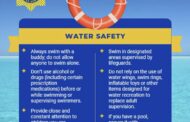The dangers of sharks in the waters of the Cape Coast received significant media attention earlier this week. Many emails were sent with photos of sharks seen or captured around our coast, and we would like to share the above one received with the caption “Fish Hoek Beach, 13/01/2010”.
Having seen this photo, many might consider staying far away from the ocean – we do however have safety tips for the brave swimmers amongst us:
• Try to avoid getting into the water when no shark nets or lifeguards are present.
• Black and White stripes mimic a poisonous predator that sharks are very likely to not get near. If you are boogie-boarding or surfing paint these patterns on for extra security. Surf pro Bethany Hammilton has this pattern and her confidence is greatly improved.
• There is currently no credible “shark repellent” commercially available, although both an electronic device and a chemical that appears to be effective have been developed in the past few years. It may be available to consumers in the near future.
• Keep pets out of the water. Their splashing and erratic movements, combined with their smaller size, may draw the attention of aggressive sharks.
• If you are diving and have fish or abalone, (when spearfishing, for example), do not tie your catch to your body. Make sure you can quickly and easily release the catch if you see a shark, and let your catch go and exit the area if a shark does show up. The shark is likely more interested in your fish than it is in you.
• Shark cages are effective, but they severely limit your ability to explore, and they’re not useful for, or available to, most divers and recreationists.
• While sharks inhabit oceans all over the world, attacks are most frequent in Florida. Other “hotspots” include Australia, Hawaii, South Africa, and California.
• Avoid swimming in murky or dirty water as this can increase the chance of a shark mistaking you for one of their usual prey sources (turtles, seals etc).
• Avoid entering the water in early mornings or late evenings/night, as this is when sharks are generally most active with their feeding and tend to move closer inshore.
• Where there are seals, there are likely sharks. Avoid swimming or kayaking in coves where seals live.























